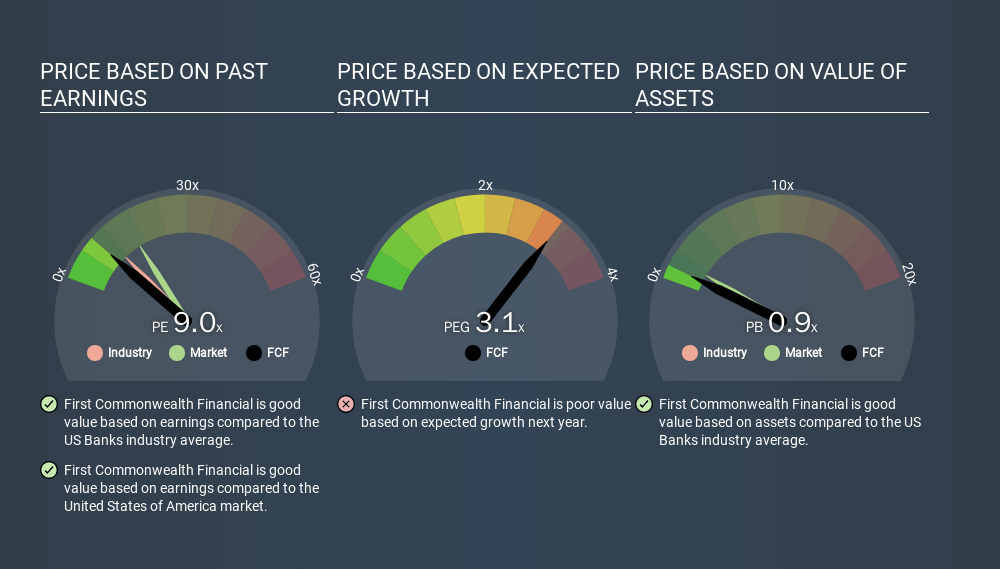- United States
- /
- Banks
- /
- NYSE:FCF
How Does First Commonwealth Financial's (NYSE:FCF) P/E Compare To Its Industry, After The Share Price Drop?

Unfortunately for some shareholders, the First Commonwealth Financial (NYSE:FCF) share price has dived 30% in the last thirty days. The recent drop has obliterated the annual return, with the share price now down 28% over that longer period.
Assuming nothing else has changed, a lower share price makes a stock more attractive to potential buyers. While the market sentiment towards a stock is very changeable, in the long run, the share price will tend to move in the same direction as earnings per share. So, on certain occasions, long term focussed investors try to take advantage of pessimistic expectations to buy shares at a better price. One way to gauge market expectations of a stock is to look at its Price to Earnings Ratio (PE Ratio). A high P/E ratio means that investors have a high expectation about future growth, while a low P/E ratio means they have low expectations about future growth.
Check out our latest analysis for First Commonwealth Financial
Does First Commonwealth Financial Have A Relatively High Or Low P/E For Its Industry?
We can tell from its P/E ratio of 9.03 that sentiment around First Commonwealth Financial isn't particularly high. If you look at the image below, you can see First Commonwealth Financial has a lower P/E than the average (10.5) in the banks industry classification.

This suggests that market participants think First Commonwealth Financial will underperform other companies in its industry. Many investors like to buy stocks when the market is pessimistic about their prospects. You should delve deeper. I like to check if company insiders have been buying or selling.
How Growth Rates Impact P/E Ratios
Generally speaking the rate of earnings growth has a profound impact on a company's P/E multiple. That's because companies that grow earnings per share quickly will rapidly increase the 'E' in the equation. And in that case, the P/E ratio itself will drop rather quickly. So while a stock may look expensive based on past earnings, it could be cheap based on future earnings.
First Commonwealth Financial saw earnings per share decrease by 1.3% last year. But it has grown its earnings per share by 18% per year over the last five years.
A Limitation: P/E Ratios Ignore Debt and Cash In The Bank
Don't forget that the P/E ratio considers market capitalization. That means it doesn't take debt or cash into account. In theory, a company can lower its future P/E ratio by using cash or debt to invest in growth.
Such spending might be good or bad, overall, but the key point here is that you need to look at debt to understand the P/E ratio in context.
First Commonwealth Financial's Balance Sheet
Net debt is 34% of First Commonwealth Financial's market cap. While that's enough to warrant consideration, it doesn't really concern us.
The Bottom Line On First Commonwealth Financial's P/E Ratio
First Commonwealth Financial trades on a P/E ratio of 9.0, which is below the US market average of 15.1. With only modest debt, it's likely the lack of EPS growth at least partially explains the pessimism implied by the P/E ratio. Given First Commonwealth Financial's P/E ratio has declined from 13.0 to 9.0 in the last month, we know for sure that the market is more worried about the business today, than it was back then. For those who prefer invest in growth, this stock apparently offers limited promise, but the deep value investors may find the pessimism around this stock enticing.
Investors should be looking to buy stocks that the market is wrong about. As value investor Benjamin Graham famously said, 'In the short run, the market is a voting machine but in the long run, it is a weighing machine. So this free visual report on analyst forecasts could hold the key to an excellent investment decision.
Of course, you might find a fantastic investment by looking at a few good candidates. So take a peek at this free list of companies with modest (or no) debt, trading on a P/E below 20.
If you spot an error that warrants correction, please contact the editor at editorial-team@simplywallst.com. This article by Simply Wall St is general in nature. It does not constitute a recommendation to buy or sell any stock, and does not take account of your objectives, or your financial situation. Simply Wall St has no position in the stocks mentioned.
We aim to bring you long-term focused research analysis driven by fundamental data. Note that our analysis may not factor in the latest price-sensitive company announcements or qualitative material. Thank you for reading.
About NYSE:FCF
First Commonwealth Financial
A financial holding company, provides various consumer and commercial banking products and services in the United States.
Flawless balance sheet average dividend payer.
Similar Companies
Market Insights
Community Narratives





